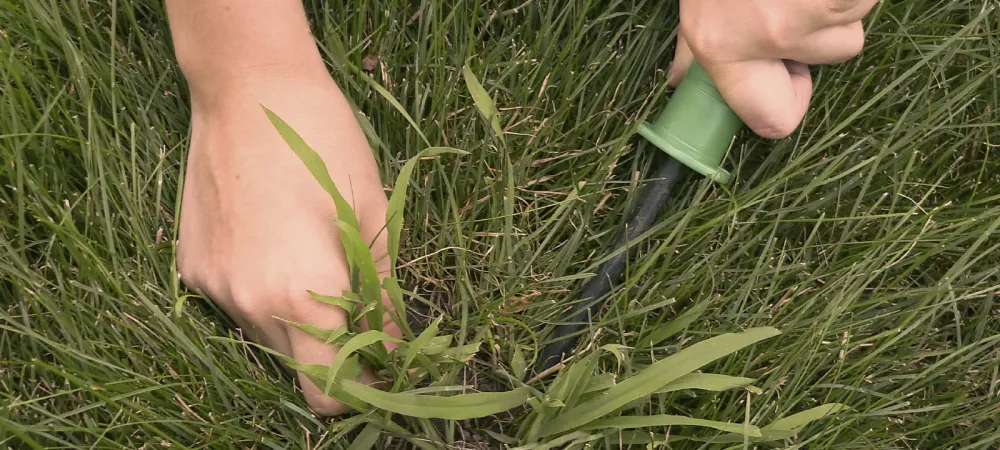How to Get Rid of Crabgrass in Your Maryland Lawn

Crabgrass is a common weed that can wreak havoc on the appearance and health of your Maryland lawn. If you're noticing patches of irregular, coarse grass taking over your well-manicured lawn, it could very well be crabgrass. But don’t worry, with the right approach, you can manage and eliminate this pesky plant. Here’s how to get rid of crabgrass and keep your lawn thriving!
What Does Crabgrass Look Like?
Crabgrass is easily identifiable by its unique growth pattern and appearance. It’s an annual weed that grows quickly, forming low-lying clusters of grass that spread out in all directions. Here are a few features to help you recognize it:
- Color: It starts out light green to yellowish-green and darkens as it matures. It has a slightly blue or purple tinge when it's stressed.
- Shape: Crabgrass grows in a low, spreading pattern. Its blades grow outward in clumps, making it stand out against your regular grass.
- Height: Crabgrass can grow anywhere from 1 inch to 3 feet tall, depending on the growing conditions and how established it is.
- Texture: The leaves are wide, coarse, and tend to be rougher than the blades of typical grass. The texture makes crabgrass feel stiffer when you walk on it.
- Seeds: In late summer, crabgrass produces large seed heads that can scatter and create even more weeds if not controlled.
In Maryland, crabgrass typically begins to show up in late spring or early summer when the temperatures rise. Crabgrass thrives in hot, dry conditions, so you may see it in areas exposed to full sun and heat. It commonly invades spots in your lawn that are thin or stressed, particularly in places where grass isn’t growing well, like near walkways, driveways, or on the edges of lawns.
How Does Crabgrass Spread?
Understanding how crabgrass spreads can help you take the necessary steps to stop it before it gets out of control.
- Seed Dispersal: The primary way crabgrass spreads is through its seeds. In late summer, mature crabgrass plants develop seed heads, which release thousands of tiny seeds that can travel by wind, water, animals, and even your lawnmower. These seeds land on bare soil or areas of the lawn that are stressed and are quick to germinate once the soil temperature rises above 55°F.
- Prolific Reproduction: A single crabgrass plant can produce up to 150,000 seeds in one growing season. If these seeds are allowed to germinate and grow, they can easily spread and establish new patches across your lawn.
- Overcrowding: As the crabgrass grows and matures, it begins to spread even further, crowding out desirable grass species and creating more room for additional crabgrass plants. This process can continue year after year if not controlled, making it harder to get rid of it in the long run.
Why Is Crabgrass Bad for Your Lawn?
Crabgrass is more than just an unsightly weed—it can become a serious problem for your lawn for several reasons:
- Competition for Resources: Crabgrass competes with your healthy grass for water, nutrients, and sunlight. This can result in thinning of your desirable grass, making it more difficult for your lawn to thrive.
- Reduced Aesthetic Appeal: As a weed, crabgrass doesn't blend in with your turf, causing unsightly patches and uneven growth.
- Difficult to Manage: Crabgrass is not only tough to remove but also spreads rapidly. If left unchecked, it can dominate areas of your lawn, making it harder for your other grasses to thrive.
- Decreased Lawn Health: The presence of crabgrass can weaken your lawn, making it more susceptible to other pests, diseases, and weeds. Additionally, crabgrass can have trouble with cold weather and doesn’t survive the winter, which may leave bare spots for other weeds to take over.
In Maryland’s climate, where summers can be hot and humid, crabgrass can easily gain a foothold if your lawn isn’t properly maintained. Keeping your lawn healthy and strong is key to preventing crabgrass from taking over.
How to Get Rid of Crabgrass
If you’re dealing with crabgrass, don’t fret! You can take several steps to control and eliminate it. Here’s a step-by-step guide:
1. Preventative Measures: Pre-Emergent Weed Control
The best defense against crabgrass is prevention. By applying a pre-emergent herbicide in early spring, you can stop crabgrass seeds from germinating in the first place.
- When to Apply: In Maryland, the ideal time to apply a pre-emergent is in early to mid-March, when soil temperatures reach around 55°F (which is when crabgrass seeds begin to germinate).
- What to Use: Look for pre-emergent herbicides containing ingredients like prodiamine or dithiopyr, which are effective in preventing crabgrass.
- Important Tip: Make sure not to disturb the soil or reseed your lawn for several weeks after applying pre-emergent treatments, as this can prevent the herbicide from working properly.
2. Spot Treatment with Post-Emergent Herbicide
If crabgrass has already invaded your lawn, you can use a post-emergent herbicide to kill the existing weeds. Post-emergent herbicides work best when applied directly to actively growing crabgrass.
- When to Apply: Apply post-emergent herbicide in late spring or early summer when the crabgrass is young and actively growing, but before it goes to seed. This will help prevent further spread.
- What to Use: Look for herbicides labeled as “selective,” as these will target the crabgrass without harming your desirable grass. Be sure to follow the manufacturer’s instructions carefully.
- Application Tips: Apply on a calm day, and make sure to only treat areas that have visible crabgrass to prevent damage to the surrounding healthy turf.
3. Hand Pulling and Spot Removal
If the crabgrass is limited to only a few areas of your lawn, you can try hand-pulling or using a hoe to remove it. This method is most effective if you catch it early before it has time to spread.
- How to Do It: Wet the soil slightly before pulling the crabgrass to loosen the roots. Gently pull the weed out by the root to ensure it doesn’t regrow.
- After Removal: Fill in the spaces with grass seed or sod to help your lawn recover quickly and prevent new weeds from growing in the bare patches.
4. Improve Lawn Health to Outcompete Crabgrass
A healthy lawn is the best defense against crabgrass. Make sure your lawn is well-fed, well-watered, and properly mowed to prevent crabgrass from taking root in the first place.
- Fertilize Regularly: Apply a balanced fertilizer in the spring and fall to encourage healthy grass growth. This will help your grass outcompete crabgrass and other weeds.
- Mow High: Set your mower to a higher setting (around 3–4 inches). Taller grass shades the soil and reduces the amount of sunlight that reaches crabgrass seeds, which helps prevent them from germinating.
- Water Wisely: Water deeply and infrequently, focusing on the root system. Shallow, frequent watering encourages crabgrass growth while deep watering promotes stronger, healthier grass.
5. Overseeding Your Lawn
After removing crabgrass, overseeding is an excellent way to strengthen your lawn and make it more resistant to weeds.
- When to Overseed: In Maryland, the best time to overseed is early fall, from mid-August to early October, when the soil is still warm and moist, and the cooler temperatures support grass seed germination.
- How to Overseed: Aerate your lawn and then apply high-quality grass seed. This will help the seed make good contact with the soil and improve the chances of successful germination. Be sure to keep the area moist until the new grass is established.
Maintaining a Crabgrass-Free Lawn in Maryland
Once you’ve dealt with crabgrass, maintaining your lawn’s health is essential to keep future outbreaks at bay. Regular lawn care practices like proper mowing, watering, and fertilizing will help ensure that your grass stays strong and resistant to crabgrass and other weeds.
By providing your lawn with the nutrients and care it needs, you can prevent crabgrass from becoming a recurring problem. It’s also important to stay vigilant during the warmer months, as crabgrass seeds can travel and germinate throughout the growing season.
Professional Crabgrass Treatments
Getting rid of crabgrass in your Maryland lawn requires a combination of preventive steps, targeted treatments, and ongoing lawn care. By acting early and maintaining a healthy lawn, you can reduce the likelihood of crabgrass returning year after year. If you're overwhelmed or unsure of where to start, consider consulting a local lawn care professional, like American Lawn & Tree Specialists, who can provide personalized weed control advice and treatment for your lawn’s specific needs.
A little time and effort now will ensure a healthier, greener lawn that’s free from crabgrass and other pesky weeds, allowing you to enjoy a beautiful yard for seasons to come.
